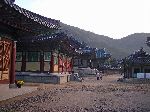Ibike Korea People-to-People Program
 Photo essay: Sangnam to
Sangwonsa
Photo essay: Sangnam to
Sangwonsa
Points of Interest: Odeasan Nat’l Park, Sangwonsa monastery
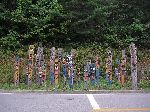
 Jang-seung,
"totem poles," usually locate in male-female pairs at the entrance to a village
on the mainland. They are smiling scary! They have a dual purpose; the
smile is suppose to welcome friend and the grin is suppose to to scare off evil. In this case they lined the roadway.
Jang-seung,
"totem poles," usually locate in male-female pairs at the entrance to a village
on the mainland. They are smiling scary! They have a dual purpose; the
smile is suppose to welcome friend and the grin is suppose to to scare off evil. In this case they lined the roadway.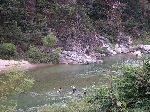
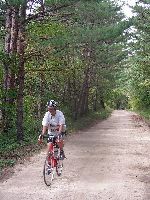
 This is our one major stretch of dirt
road (25 km). It started out packed and reasonably smooth. Most of
the way to Duroryeong Pass (11 km) is was a consistent grade and quite
ride-able. There are short stretches that are rocky and steep so it is
convenient to dismount and enjoy a forest walk for a few minutes. The
worst sections are on the first few kilometers of descent, south of the pass,
where the surface was loose gravel and rock and also deserving of a relaxed pass
off the bike.
This is our one major stretch of dirt
road (25 km). It started out packed and reasonably smooth. Most of
the way to Duroryeong Pass (11 km) is was a consistent grade and quite
ride-able. There are short stretches that are rocky and steep so it is
convenient to dismount and enjoy a forest walk for a few minutes. The
worst sections are on the first few kilometers of descent, south of the pass,
where the surface was loose gravel and rock and also deserving of a relaxed pass
off the bike. 
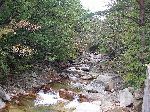
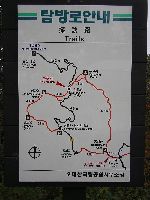 K'inpokdeanol (steam)
(left), Odaesan
National Park. Duroryeong Pass is the trail head for
several trails leading to mountain temples, hermitages and peaks (right).
K'inpokdeanol (steam)
(left), Odaesan
National Park. Duroryeong Pass is the trail head for
several trails leading to mountain temples, hermitages and peaks (right).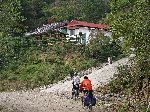

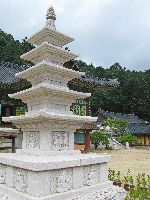
It is said that in 705 AD two Shilla princes, Poch'on and Hyomyong, came to the Odea Mountains to pray to Manjusri Bodhisattva* and built a hermitage here. Pochon later established the Chinyowon prayer temple on this site. (*A being who aspires to perfect enlightenment in order to save others. Manjusri personifies wisdom and is often depicted holding a sword which he uses to cut through the veil of ignorance.)
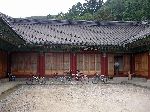
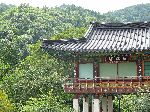 We were granted permission by the
monks to overnight (pre-arranged) at Sangwonsa (temple). We were given
bicycle parking, just outside of our dormitory. The rooms were "ondol" and
had no accessories, except for electric lights. As is expected of guest
we participated in the major activities during our stay.
We were granted permission by the
monks to overnight (pre-arranged) at Sangwonsa (temple). We were given
bicycle parking, just outside of our dormitory. The rooms were "ondol" and
had no accessories, except for electric lights. As is expected of guest
we participated in the major activities during our stay.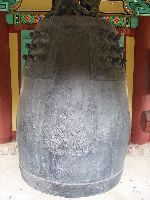


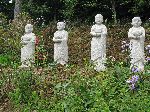
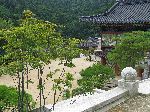

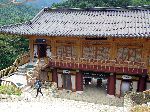 Most of the buildings at the temple
fall into two categories; living quarters and those used for prayer. There
are a number of shines used for pray. We joined the monks for their first
prays of the day at 3 a.m. They then do chore, have breakfast at 6 a.m. and then
study or pray in one of the shrines for the morning. The juxtaposition of
nature, the multiple graceful rooflines of the building, the changing light and
the ambiance of activity (including chanting), generates a spiritual aura.
Most of the buildings at the temple
fall into two categories; living quarters and those used for prayer. There
are a number of shines used for pray. We joined the monks for their first
prays of the day at 3 a.m. They then do chore, have breakfast at 6 a.m. and then
study or pray in one of the shrines for the morning. The juxtaposition of
nature, the multiple graceful rooflines of the building, the changing light and
the ambiance of activity (including chanting), generates a spiritual aura.
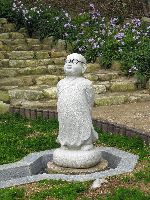 Basic temple etiquette:
Basic temple etiquette:- Generally be quiet
- Wear long pants
- Don't enter a temple or room directly in front of Buddha, use a side door (some senior monks are given this privilege.)
- Remove you shoes, but no bare feet (wear socks), when entering a temple.
- Pay your respect to Buddha by bowing three times
- Don't take pictures while inside a temple
- If you eat a meal, eat all the rice you take
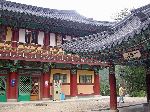
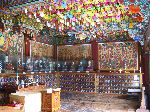 Part of a monks existence is to live
simply. Some of the most enlightened monks are noted for owning only their
robes and a cup. Without trying to reconcile it, I noted the temple had a
coffee machine and telephones, the business office used computers and the monks
traveled in SUVs.
Part of a monks existence is to live
simply. Some of the most enlightened monks are noted for owning only their
robes and a cup. Without trying to reconcile it, I noted the temple had a
coffee machine and telephones, the business office used computers and the monks
traveled in SUVs.
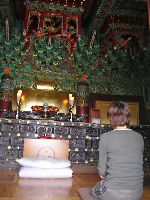 The Jeokmyeolbogung is the sanctum of
the temple. The Sarira (mineral pieces left in the ashes of the cremation
of a Buddhist master) of the Buddha were placed here. This is one of the
five most important Jeokmyeolbogungs in Korea. Legend says that the
Buddhist monk Jajangyulsa brought back the Sarira fo the Buddha when he returned
from China. He enshrined them in the Jeokmyeolbogung. The legend survives and Jeokmyeolbogung is revered as
a resting place of Buddha remains. People make special pilgrimages to this
temple. It is a steep two kilometer climb from the nearest road.
The Jeokmyeolbogung is the sanctum of
the temple. The Sarira (mineral pieces left in the ashes of the cremation
of a Buddhist master) of the Buddha were placed here. This is one of the
five most important Jeokmyeolbogungs in Korea. Legend says that the
Buddhist monk Jajangyulsa brought back the Sarira fo the Buddha when he returned
from China. He enshrined them in the Jeokmyeolbogung. The legend survives and Jeokmyeolbogung is revered as
a resting place of Buddha remains. People make special pilgrimages to this
temple. It is a steep two kilometer climb from the nearest road.
 Please
contact us if you would like to be added to
Ibike's mailing list or have questions, comments, corrections or criticism. (Also, please let us know how you learned about us and
found this site.) Privacy policy.
Please
contact us if you would like to be added to
Ibike's mailing list or have questions, comments, corrections or criticism. (Also, please let us know how you learned about us and
found this site.) Privacy policy.
![]() IBF Homepage
IBF Homepage ![]() Ibike Programs
Ibike Programs
![]() Ibike Schedule
Ibike Schedule
![]() Search
Search
